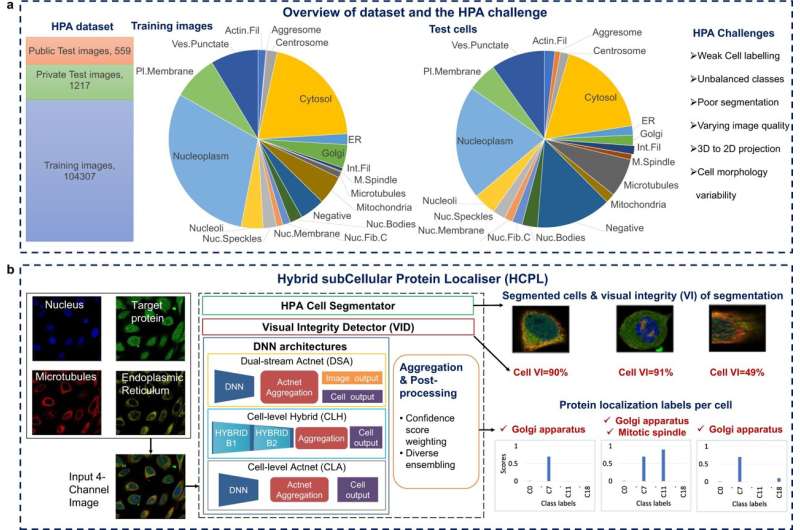This article has been reviewed according to Science X's editorial process and policies. Editors have highlighted the following attributes while ensuring the content's credibility:
fact-checked
peer-reviewed publication
trusted source
proofread
Newly developed AI shows speed and accuracy in identifying the location and expression of proteins

A new advanced artificial intelligence (AI) system has shown world-leading accuracy and speed in identifying protein patterns within individual cells. The new system, developed at the University of Surrey's Institute for People-Centered AI, could help scientists understand differences in cancer tumors and identify new drugs for diseases.
In a study published in Communications Biology, researchers demonstrate how the HCPL (Hybrid subCellular Protein Localizer) requires only partially labeled data to learn how to decipher the locations of proteins within cellular structures and their behavior in different cells.
The team tested the HCPL on the Human Protein Atlas and found it to be the most accurate tool for identifying the location of proteins within individual cells.
Professor Miroslaw Bober, leader of the HCPL project from the University of Surrey, said, "To understand how proteins work inside cells, scientists need to study where they are located, but this can be a time-consuming and complicated process. HCPL makes this process easier.
"This program uses a deep-learning model to quickly and accurately identify subcellular structures where proteins are present inside individual cells. We are hopeful that HCPL can help scientists study how proteins work and develop new treatments for diseases."
Spatial proteomics is a research area that studies the distribution of proteins in cells or tissues using a combination of experimental techniques and computational approaches. Fluorescence microscopy is a common method in this field where proteins are physically tagged with fluorescent markers. AI maps the proteins onto individual cell compartments (subcellular structures or organelles). This helps scientists to understand the roles and functions of proteins and possibly reveal the complex inner workings of cells.
HCPL was developed in partnership with ForecomAI, a research and development company with world-class expertise in machine and deep learning providing solutions in health care and biosciences.
Dr. Amaia Irizar, director of ForecomAI said, "Proteins play a key role in most cellular processes crucial to our survival. Unraveling protein distributions and interactions within individual cells is vital to understanding their functions and indispensable to developing new treatments.
"Our work with the University of Surrey enables scaling up of this process and opens new frontiers. The partnership between Surrey and ForecomAI has been a successful interdisciplinary collaboration in scientific research, paving the way for further initiatives."
More information: Syed Sameed Husain et al, Single-cell subcellular protein localisation using novel ensembles of diverse deep architectures, Communications Biology (2023). DOI: 10.1038/s42003-023-04840-z
Journal information: Communications Biology
Provided by University of Surrey




















